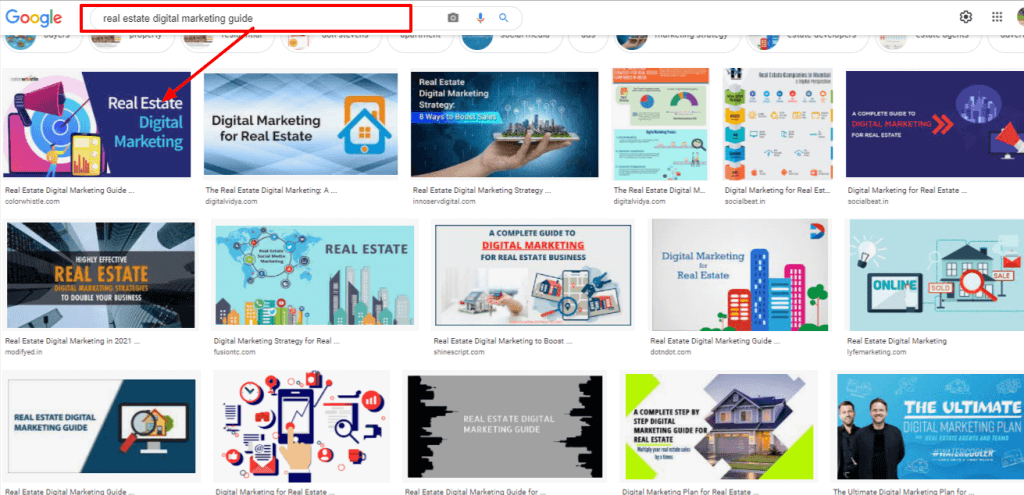There is an old saying by Henrik Isben, ‘a picture is worth a thousand words’, and the same holds true with digital media where images continue to grab immediate user attention.
A study shows real estate property listings with more than 20 photographs and videos sell 32% faster than listings with fewer photographs.
However, the biggest challenge for realtors now, is how to utilize digital technology to be competitive in the real estate industry as 90% of realtors are using the digital platform.
Marketers suggest combining campaigns with special Search Engine Optimization (SEO) strategies to list property images higher up in the SERP.
Taking good photographs of listings and uploading them is not the only thing but optimizing the images for search engines bring life to your real estate website. In the following video link, John Mueller, Search Advocate at Google explains how to use images to achieve your site’s goal:
Optimizing Images for Better SERP
Following are some of the proven image SEO techniques to drive more traffic to your real estate website:
1. Find Right Images
Make your real estate website more enticing by adding images. While choosing images, make sure your selected images are vector images as they are more scalable and easy to use. On the other hand, raster images are images with huge dimensions and large in size. It may affect the loading speed of your real estate website pages. However, raster images can provide real depth to the imagery.
Simply put, choose to upload images in file extensions: .SVG, .EPS, .PDF, .AI, .DXF while reserving file extensions like .BMP, .JPEG, .PNG, .GIF, .TIF for other specific purposes.
Choose unique and high-quality images rather than stock images to stand out from the competitors. Though the stock images get optimized, they may not have the same SEO impact as unique and original photos have. When you use photographs, try to choose the relevant photographs that should reflect the purpose of your real estate business.
The use of more original pictures provides a better ranking for your real estate website on relevant searches. If you don’t have original photographs, try to get unique ones from any other image sources including Unsplash, and Flickr.com. You can also use illustrations and charts to get better SERP.
2. Prepare Images to Upload to Your Website
Once you have the perfect images for your real estate website, the next step is to make these images easy to optimize for SEO.
Here are some of the tips to make your image search engine friendly:
Reduce file size
Compress your real estate images before uploading them to the website for better image optimization. Always use the smallest file size with the highest quality if possible. The designers can use different types of tools to compress your image without losing its quality. Following are some of the compression tools:
The file size of images is not the same for every social media platform and website. Refer to the following table to know the image sizes across social media:
| Facebook | Tumblr | |||
|---|---|---|---|---|
| Cover Image: 828x315 | Profile Image: 180X180 | Header Image: 1500X500 | Profile Image: 110X110 | Profile Image: 128X128 |
| Profile Image: 180x180 | Board Cover Image: 214X100 | Profile Image: 400X400 | Image Thumbnail: 161X161 | Image Post: 500X750 |
| Shared Image:1200X900 | Pin Preview: 238 pixels | Timeline Image: 506X253 | Shared Images: 1080X1080 | |
| Shared Link Preview Image: 1200X628 | Shared Videos: 1080 pixels |
Choose right filename
Once you choose the right file format, the next step is to find out the right filename before publishing the images on your website or social media pages. When optimizing real estate photographs, the keyword-rich filename matters for better image SEO. Use a descriptive filename that helps to make search engines index your real estate images easily. Always try to use the focus keyword at the beginning of the image file name to make your image more SEO-friendly.
Do check out this blog post to know more about image audits for SEO.
Responsive Images
Responsive real estate images drive more traffic to your website as they can be accessed from any device. It also enhances the user experience while enabling users to visit your website either from mobile or computer. Mozilla offers two attributes such as srcset and sizes that allow developers to add more source images. It helps browsers to choose the most suitable image size.
Scaling Images
Scaling images properly increases the loading speed of your real estate web pages. When you use large images, it may affect the loading speed and image SEO. Scaling an image not only means reducing its width and height but also refers to its resolution. For better image SEO and user experience, resize the image to the size of the image display.
3. Adding Image to the Website
While adding images to the website or social media platform, you should provide the context to the specific image and also make sure that the image is relevant to the topic. Here are some tips to consider while adding images:
Captions
Add suitable captions to the images as it plays a vital role in image SEO. When people visit your real estate website, most of them only go through the images and captions. Therefore, captions should be relevant and should provide a clear description. However, not all images really need captions. It may lead to getting your website over-optimized, therefore, add captions where it only makes sense to the readers.
Image File Structure
Structured Image file helps search engines to understand your website easily. To structure your images, you can use Schema.org vocabularies. The Schema vocabularies are developed by the search engines to understand the different types of content. Structured file images enhance the visibility of your real estate images by appearing top on the SERPs.
Image Titles
Image titles help search engines to identify the image appropriately. The image title should contain focus keywords and the keyword-rich titles provide better ranking to your real estate website.
Alt text
The alt text or alt tags are as important as the image title but they can be more expressive than the image title. Therefore, digital marketers can use more relevant and targeted keywords in the alt text. Alt text should provide a better description of the image that facilitates search engines to index the image. Search engines give more priority to alt texts as it determines what the image is all about.
For example, if you have a picture of the house on your web page, the alt text can be: <img src=”house-1.jpg” alt=” white painted house with grey color roof”/>
When the web pages with images take more time to load, the alt tag appears in the image box. Therefore, the alt tag should contain the relevant content that suits the image. It helps readers to guess what the image to be. Adding alt text to the image provides a better user experience. Above all, alt tags help your website to be ranked high in the SERPs.
The following video link provides a better idea of how to create a file name, Alt text, and title.
4. Image Site Map
While adding images to your real estate website, create a sitemap for images or add images to an existing sitemap. Adding images to the sitemap enhances the chances to get crawling and indexing on the major search engines. Developers can use Google’s image extensions for sitemaps to drive more traffic to your real estate website. Adding real estate photographs to the sitemap helps search engines to index your images for improving image SEO.
5. Use a Content Delivery Network
The use of CDN helps you to optimize your real estate images and to provide visitors quickly. Most of the CDN providers also have image CDN that can accelerate the delivery of your real estate images. Image CDN facilitates you to transform, optimize and deliver images. It can convert all your PNG file images to WebP to provide the best quality images without affecting the loading speed.
Click here for additional tips on formatting and resizing images on your real estate websites and blogs.

Use of Images for Local SEO
Adding relevant real estate images in various local directories helps to bring a more targeted audience to your website. It also enhances the credibility of your real estate business. Here are some of the image tips for local SEO:
- Provide images of your real estate office and employees.
- Provide maximum images of property listings.
- Add your sitemap on local business websites.
- Add alt text to the images. Try not to over-stuff keywords into ALT text.
- Provide captions to the images.
Concluding Remarks
Optimizing images undoubtedly improves the user experience of your real estate website. Not the images can alone make sense to the Image SEO, but the right images with above all the elements provide a better SERP for your website.
We encourage you to follow & practice the above tips to optimize property images for SEO. If you may know, there are also professionals at your reach to help you with image design, build custom SEO strategies, and more for your online real estate business.
We hope you liked this post. Show us your appreciation by commenting down below. You may also call us for any business query at +1 (919) 234-5140 or send us a message here.





